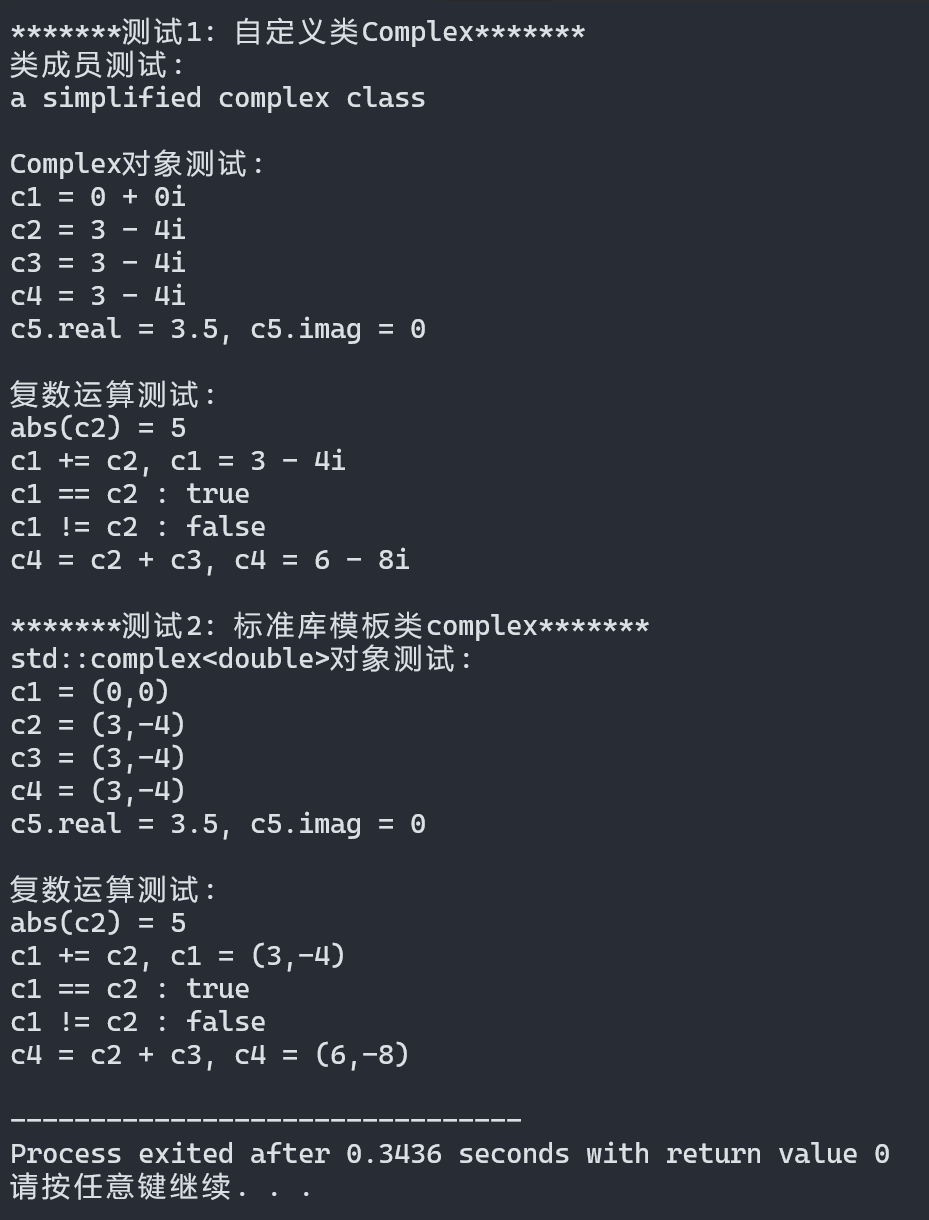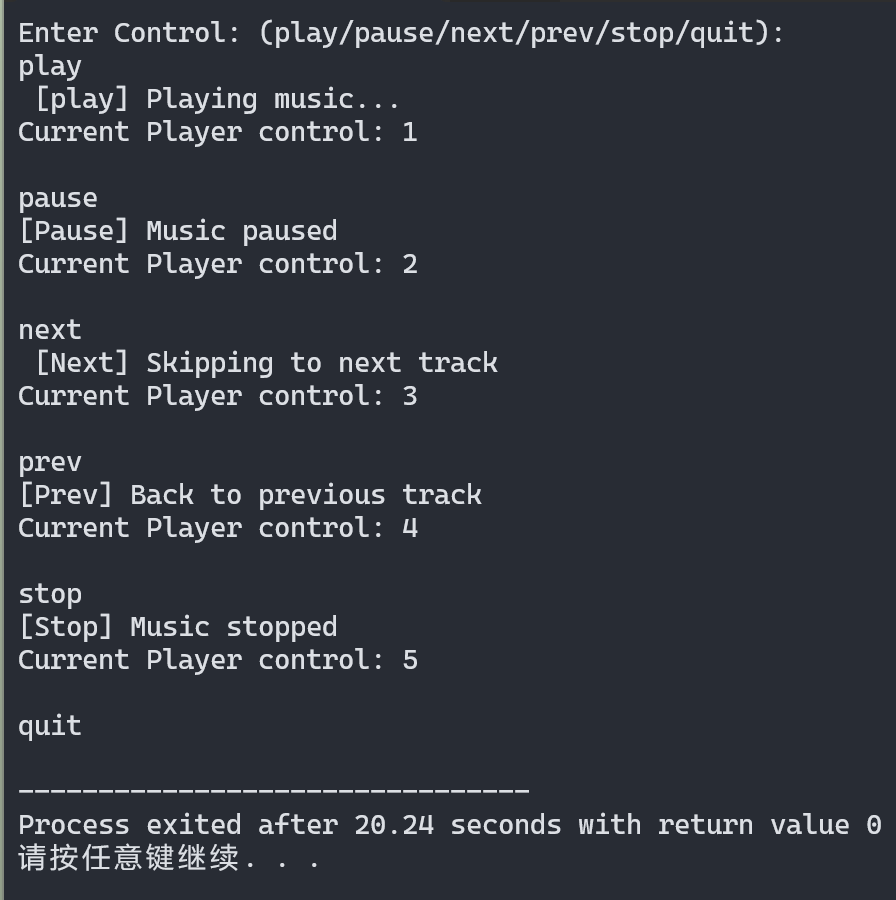实验2
一、实验结论
1. 实验任务1
程序源代码
T.h
#pragma once
#include <string>
// 类T: 声明
class T {
// 对象属性、方法
public:
T(int x = 0, int y = 0); // 普通构造函数
T(const T &t); // 复制构造函数
T(T &&t); // 移动构造函数
~T(); // 析构函数
void adjust(int ratio); // 按系数成倍调整数据
void display() const; // 以(m1, m2)形式显示T类对象信息
private:
int m1, m2;
// 类属性、方法
public:
static int get_cnt(); // 显示当前T类对象总数
public:
static const std::string doc; // 类T的描述信息
static const int max_cnt; // 类T对象上限
private:
static int cnt; // 当前T类对象数目
// 类T友元函数声明
friend void func();
};
// 普通函数声明
void func();
T.cpp
#include "T.h"
#include <iostream>
#include <string>
// 类T实现
// static成员数据类外初始化
const std::string T::doc{"a simple class sample"};
const int T::max_cnt = 999;
int T::cnt = 0;
// 类方法
int T::get_cnt() {
return cnt;
}
// 对象方法
T::T(int x, int y): m1{x}, m2{y} {
++cnt;
std::cout << "T constructor called.\n";
}
T::T(const T &t): m1{t.m1}, m2{t.m2} {
++cnt;
std::cout << "T copy constructor called.\n";
}
T::T(T &&t): m1{t.m1}, m2{t.m2} {
++cnt;
std::cout << "T move constructor called.\n";
}
T::~T() {
--cnt;
std::cout << "T destructor called.\n";
}
void T::adjust(int ratio) {
m1 *= ratio;
m2 *= ratio;
}
void T::display() const {
std::cout << "(" << m1 << ", " << m2 << ")" ;
}
// 普通函数实现
void func() {
T t5(42);
t5.m2 = 2049;
std::cout << "t5 = "; t5.display(); std::cout << '\n';
}
task1.cpp
#include "T.h"
#include <iostream>
void test_T();
int main() {
std::cout << "test Class T: \n";
test_T();
std::cout << "\ntest friend func: \n";
func();
}
void test_T() {
using std::cout;
using std::endl;
cout << "T info: " << T::doc << endl;
cout << "T objects'max count: " << T::max_cnt << endl;
cout << "T objects'current count: " << T::get_cnt() << endl << endl;
T t1;
cout << "t1 = "; t1.display(); cout << endl;
T t2(3, 4);
cout << "t2 = "; t2.display(); cout << endl;
T t3(t2);
t3.adjust(2);
cout << "t3 = "; t3.display(); cout << endl;
T t4(std::move(t2));
cout << "t4 = "; t4.display(); cout << endl;
cout << "test: T objects'current count: " << T::get_cnt() << endl;
}
运行测试截图

问题1:T.h中,在类T内部,已声明 func 是T的友元函数。在类外部,去掉line36,重新编译,程序能否正常运行。
YES
问题2: T.h中,line9-12给出了各种构造函数、析构函数。总结它们各自的功能、调用时机。
普通构造函数:创建新对象时调用,用于初始化对象数据成员
复制构造函数:用已存在对象创建新对象时调用,进行深拷贝
移动构造函数:使用右值引用创建对象时调用,转移资源所有权
析构函数:对象生命周期结束时调用,用于清理资源
问题3: T.cpp中,line13-15,剪切到T.h的末尾,重新编译,程序能否正确编译。如不能,以截图形式给出报错信息,分析原因。
2.实验任务2
程序源代码
Complex.h
#pragma once
#include <string>
class Complex {
public:
Complex(double real = 0.0, double imag = 0.0);
Complex(const Complex& other);
double get_real() const;
double get_imag() const;
void add(const Complex& other);
static const std::string doc;
private:
double real, imag;
friend void output(const Complex& c);
friend double abs(const Complex& c);
friend Complex add(const Complex& c1, const Complex& c2);
friend bool is_equal(const Complex& c1, const Complex& c2);
friend bool is_not_equal(const Complex& c1, const Complex& c2);
};
void output(const Complex& c);
double abs(const Complex& c);
Complex add(const Complex& c1, const Complex& c2);
bool is_equal(const Complex& c1, const Complex& c2);
bool is_not_equal(const Complex& c1, const Complex& c2);
Complex.cpp
#include "Complex.h"
#include <iostream>
#include <cmath>
const std::string Complex::doc = "a simplified complex class";
Complex::Complex(double r, double i) : real(r), imag(i) {}
Complex::Complex(const Complex& other) : real(other.real), imag(other.imag) {}
double Complex::get_real() const {
return real;
}
double Complex::get_imag() const {
return imag;
}
void Complex::add(const Complex& other) {
real += other.real;
imag += other.imag;
}
void output(const Complex& c) {
std::cout << c.real;
if (c.imag >= 0)
std::cout << " + " << c.imag << "i";
else
std::cout << " - " << -c.imag << "i";
}
double abs(const Complex& c) {
return std::sqrt(c.real * c.real + c.imag * c.imag);
}
Complex add(const Complex& c1, const Complex& c2) {
return Complex(c1.real + c2.real, c1.imag + c2.imag);
}
bool is_equal(const Complex& c1, const Complex& c2) {
return c1.real == c2.real && c1.imag == c2.imag;
}
bool is_not_equal(const Complex& c1, const Complex& c2) {
return !is_equal(c1, c2);
}
task2.cpp
// 待补足头文件
#include "Complex.h"
#include <iostream>
#include <iomanip>
#include <complex>
void test_Complex();
void test_std_complex();
int main() {
std::cout << "*******测试1: 自定义类Complex*******\n";
test_Complex();
std::cout << "\n*******测试2: 标准库模板类complex*******\n";
test_std_complex();
}
void test_Complex() {
using std::cout;
using std::endl;
using std::boolalpha;
cout << "类成员测试: " << endl;
cout << Complex::doc << endl << endl;
cout << "Complex对象测试: " << endl;
Complex c1;
Complex c2(3, -4);
Complex c3(c2);
Complex c4 = c2;
const Complex c5(3.5);
cout << "c1 = "; output(c1); cout << endl;
cout << "c2 = "; output(c2); cout << endl;
cout << "c3 = "; output(c3); cout << endl;
cout << "c4 = "; output(c4); cout << endl;
cout << "c5.real = " << c5.get_real()
<< ", c5.imag = " << c5.get_imag() << endl << endl;
cout << "复数运算测试: " << endl;
cout << "abs(c2) = " << abs(c2) << endl;
c1.add(c2);
cout << "c1 += c2, c1 = "; output(c1); cout << endl;
cout << boolalpha;
cout << "c1 == c2 : " << is_equal(c1, c2) << endl;
cout << "c1 != c2 : " << is_not_equal(c1, c2) << endl;
c4 = add(c2, c3);
cout << "c4 = c2 + c3, c4 = "; output(c4); cout << endl;
}
void test_std_complex() {
using std::cout;
using std::endl;
using std::boolalpha;
cout << "std::complex<double>对象测试: " << endl;
std::complex<double> c1;
std::complex<double> c2(3, -4);
std::complex<double> c3(c2);
std::complex<double> c4 = c2;
const std::complex<double> c5(3.5);
cout << "c1 = " << c1 << endl;
cout << "c2 = " << c2 << endl;
cout << "c3 = " << c3 << endl;
cout << "c4 = " << c4 << endl;
cout << "c5.real = " << c5.real()
<< ", c5.imag = " << c5.imag() << endl << endl;
cout << "复数运算测试: " << endl;
cout << "abs(c2) = " << abs(c2) << endl;
c1 += c2;
cout << "c1 += c2, c1 = " << c1 << endl;
cout << boolalpha;
cout << "c1 == c2 : " << (c1 == c2)<< endl;
cout << "c1 != c2 : " << (c1 != c2) << endl;
c4 = c2 + c3;
cout << "c4 = c2 + c3, c4 = " << c4 << endl;
}
运行测试截图

问题1:比较自定义类 Complex 和标准库模板类 complex 的用法,在使用形式上,哪一种更简洁?函数和运算内在有关联吗?
标准库模板类complex的用法更简洁,因为它重载了运算符,可以直接使用+、-、==等数学运算符,更符合数学直觉。函数和运算内在确实有关联,运算符重载让代码更自然。
问题2:2-1:自定义 Complex 中, output/abs/add/ 等均设为友元,它们真的需要访问 私有数据 吗?(回答“是/否”并给出理由)
是。因为这些函数需要访问Complex类的私有数据成员real和imag来计算或输出结果。
2-2:标准库 std::complex 是否把 abs 设为友元?(查阅 cppreference后回答)
标准库std::complex没有把abs设为友元,因为std::abs是一个自由函数,通过公有接口访问复数数据。
2-3:什么时候才考虑使用 friend?总结你的思考。
当非成员函数需要访问类的私有成员,且该函数在逻辑上是类接口的一部分时。
问题3:如果构造对象时禁用=形式,即遇到 Complex c4 = c2; 编译报错,类Complex的设计应如何调整?
3.实验任务3
程序源代码
PlayerControl.h
#pragma once
#include <string>
enum class ControlType {Play, Pause, Next, Prev, Stop, Unknown};
class PlayerControl {
public:
PlayerControl();
ControlType parse(const std::string& control_str); // 实现std::string --> ControlType转换
void execute(ControlType cmd) const; // 执行控制操作(以打印输出模拟)
static int get_cnt();
private:
static int total_cnt;
};
PlayerControl.cpp
#include "PlayerControl.h"
#include <iostream>
#include <algorithm>
int PlayerControl::total_cnt = 0;
PlayerControl::PlayerControl() {}
// 待补足
// 1. 将输入字符串转为小写,实现大小写不敏感
// 2. 匹配"play"/"pause"/"next"/"prev"/"stop"并返回对应枚举
// 3. 未匹配的字符串返回ControlType::Unknown
// 4. 每次成功调用parse时递增total_cnt
ControlType PlayerControl::parse(const std::string& control_str) {
std::string lower_str = control_str;
std::transform(lower_str.begin(), lower_str.end(), lower_str.begin(),
[](unsigned char c){ return std::tolower(c); });
if (lower_str == "play") {
++total_cnt;
return ControlType::Play;
} else if (lower_str == "pause") {
++total_cnt;
return ControlType::Pause;
} else if (lower_str == "next") {
++total_cnt;
return ControlType::Next;
} else if (lower_str == "prev") {
++total_cnt;
return ControlType::Prev;
} else if (lower_str == "stop") {
++total_cnt;
return ControlType::Stop;
} else {
return ControlType::Unknown;
}
}
void PlayerControl::execute(ControlType cmd) const {
switch (cmd) {
case ControlType::Play: std::cout << " [play] Playing music...\n"; break;
case ControlType::Pause: std::cout << "[Pause] Music paused\n"; break;
case ControlType::Next: std::cout << " [Next] Skipping to next track\n"; break;
case ControlType::Prev: std::cout << "[Prev] Back to previous track\n"; break;
case ControlType::Stop: std::cout << "[Stop] Music stopped\n"; break;
default: std::cout << "[Error] unknown control\n"; break;
}
}
int PlayerControl::get_cnt() {
return total_cnt;
}
task3.cpp
#include "PlayerControl.h"
#include <iostream>
void test() {
PlayerControl controller;
std::string control_str;
std::cout << "Enter Control: (play/pause/next/prev/stop/quit):\n";
while(std::cin >> control_str) {
if(control_str == "quit")
break;
ControlType cmd = controller.parse(control_str);
controller.execute(cmd);
std::cout << "Current Player control: " << PlayerControl::get_cnt() << "\n\n";
}
}
int main() {
test();
}
运行测试截图

4.实验任务4
Fraction.h
#pragma once
#include <string>
class Fraction {
public:
Fraction(int up = 0, int down = 1);
Fraction(const Fraction& other);
int get_up() const;
int get_down() const;
Fraction negative() const;
static const std::string doc;
private:
int up, down;
void simplify();
static int gcd(int a, int b);
friend void output(const Fraction& f);
friend Fraction add(const Fraction& f1, const Fraction& f2);
friend Fraction sub(const Fraction& f1, const Fraction& f2);
friend Fraction mul(const Fraction& f1, const Fraction& f2);
friend Fraction div(const Fraction& f1, const Fraction& f2);
};
void output(const Fraction& f);
Fraction add(const Fraction& f1, const Fraction& f2);
Fraction sub(const Fraction& f1, const Fraction& f2);
Fraction mul(const Fraction& f1, const Fraction& f2);
Fraction div(const Fraction& f1, const Fraction& f2);
Fraction.cpp
#include "Fraction.h"
#include <iostream>
#include <stdexcept>
#include <cmath>
const std::string Fraction::doc =
"Fraction类 v 0.01版. \n"
"目前仅支持分数对象的构造、输出、加/减/乘/除运算.";
Fraction::Fraction(int u, int d) : up(u), down(d) {
if (down == 0) {
throw std::invalid_argument("分母不能为0");
}
simplify();
}
Fraction::Fraction(const Fraction& other) : up(other.up), down(other.down) {}
int Fraction::get_up() const {
return up;
}
int Fraction::get_down() const {
return down;
}
Fraction Fraction::negative() const {
return Fraction(-up, down);
}
int Fraction::gcd(int a, int b) {
a = std::abs(a);
b = std::abs(b);
while (b != 0) {
int temp = b;
b = a % b;
a = temp;
}
return a;
}
void Fraction::simplify() {
if (down < 0) {
up = -up;
down = -down;
}
int common = gcd(up, down);
up /= common;
down /= common;
}
void output(const Fraction& f) {
if (f.down == 1) {
std::cout << f.up;
} else {
std::cout << f.up << "/" << f.down;
}
}
Fraction add(const Fraction& f1, const Fraction& f2) {
int new_up = f1.up * f2.down + f2.up * f1.down;
int new_down = f1.down * f2.down;
return Fraction(new_up, new_down);
}
Fraction sub(const Fraction& f1, const Fraction& f2) {
int new_up = f1.up * f2.down - f2.up * f1.down;
int new_down = f1.down * f2.down;
return Fraction(new_up, new_down);
}
Fraction mul(const Fraction& f1, const Fraction& f2) {
int new_up = f1.up * f2.up;
int new_down = f1.down * f2.down;
return Fraction(new_up, new_down);
}
Fraction div(const Fraction& f1, const Fraction& f2) {
if (f2.up == 0) {
throw std::invalid_argument("除数不能为0");
}
int new_up = f1.up * f2.down;
int new_down = f1.down * f2.up;
return Fraction(new_up, new_down);
}
task4.cpp
#include "Fraction.h"
#include <iostream>
void test1();
void test2();
int main() {
std::cout << "测试1: Fraction类基础功能测试\n";
test1();
std::cout << "\n测试2: 分母为0测试: \n";
test2();
}
void test1() {
using std::cout;
using std::endl;
cout << "Fraction类测试: " << endl;
cout << Fraction::doc << endl << endl;
Fraction f1(5);
Fraction f2(3, -4), f3(-18, 12);
Fraction f4(f3);
cout << "f1 = "; output(f1); cout << endl;
cout << "f2 = "; output(f2); cout << endl;
cout << "f3 = "; output(f3); cout << endl;
cout << "f4 = "; output(f4); cout << endl;
const Fraction f5(f4.negative());
cout << "f5 = "; output(f5); cout << endl;
cout << "f5.get_up() = " << f5.get_up()
<< ", f5.get_down() = " << f5.get_down() << endl;
cout << "f1 + f2 = "; output(add(f1, f2)); cout << endl;
cout << "f1 - f2 = "; output(sub(f1, f2)); cout << endl;
cout << "f1 * f2 = "; output(mul(f1, f2)); cout << endl;
cout << "f1 / f2 = "; output(div(f1, f2)); cout << endl;
cout << "f4 + f5 = "; output(add(f4, f5)); cout << endl;
}
void test2() {
using std::cout;
using std::endl;
Fraction f6(42, 55), f7(0, 3);
cout << "f6 = "; output(f6); cout << endl;
cout << "f7 = "; output(f7); cout << endl;
cout << "f6 / f7 = "; output(div(f6, f7)); cout << endl;
}
运行测试截图

问题回答:分数的输出和计算, output/add/sub/mul/div ,你选择的是哪一种设计方案?(友元/自由函数/命名空间+自由函数/类+static)
你的决策理由?如友元方案的优缺点、静态成员函数方案的适用场景、命名空间方案的考虑因素等。
我选择使用友元方案来实现分数的输出和计算函数。
决策理由:
友元方案的优点:可以直接访问类的私有成员,实现更高效,代码更简洁
友元方案的缺点:破坏了封装性,增加了类之间的耦合
静态成员函数方案:适用于不需要访问特定对象实例但需要访问类私有成员的场景
命名空间方案:适用于组织相关功能,但无法直接访问私有成员
对于分数运算,这些函数在逻辑上是分数类接口的重要组成部分,使用友元可以让实现更加自然和高效。




 浙公网安备 33010602011771号
浙公网安备 33010602011771号